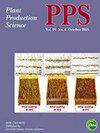粳稻和籼稻品种籽粒氮素分配相关参数数量性状位点的鉴定与验证
IF 1.3
3区 农林科学
Q2 AGRONOMY
引用次数: 0
摘要
氮素分配影响水稻产量和籽粒品质。摘要本研究旨在阐明粳稻‘Momiroman’和籼稻‘Takanari’在每粒干重地上部全氮量(TNA/GW)与籽粒氮浓度(GNC)关系上的差异,并利用Momiroman和Takanari杂交群体确定与这一关系系数相关的数量性状位点(qtl)。并利用近等基因系(NILs)验证检测到的qtl的效应。选取2015年高氮栽培的156株F2和2016年高氮或低氮栽培的156株F3,测定籽粒和地上营养部位的氮浓度和含量。我们发现Momiroman和Takanari地区的GNC与TNA/GW呈对数关系。回归系数(A)在Takanari地区较高。在每个N条件下,计算每个群体的A,并进行QTL分析。在所有条件下均在6号和10号染色体上检测到A的qtl;两个qtl的Takanari等位基因均增加了价值。各区域Takanari等位基因NILs的A值均高于Momiroman等位基因NILs。我们认为,A的qtl与水稻氮素分配有关。缩写:GNA,籽粒中N含量;GNC,籽粒氮浓度;GW:谷物干重;TNA,地上部分的N量本文章由计算机程序翻译,如有差异,请以英文原文为准。
Identification and validation of quantitative trait loci for a parameter associated with nitrogen partitioning to grain using a population derived from japonica- and indica-type cultivars of rice (Oryza sativa L.)
ABSTRACT Nitrogen (N) partitioning to grain affects productivity and grain quality in rice. The objectives of this study were to clarify the difference between the rice cultivars ‘Momiroman’ (japonica) and ‘Takanari’ (indica) in the relation between the amount of total N in aboveground parts per grain dry weight (TNA/GW) and grain N concentration (GNC), to identify quantitative trait loci (QTLs) associated with the coefficient characterizing this relation by using populations derived from a cross between Momiroman and Takanari, and to verify the effects of the detected QTLs by using near-isogenic lines (NILs). We used 156 F2 plants grown under high N in 2015 and 156 F3 lines grown under high or low N in 2016, and determined N concentrations and contents in grain and aboveground vegetative parts. We found a logarithmic relation between GNC and TNA/GW in Momiroman and Takanari. The regression coefficient (A) was higher in Takanari. Under each N condition, A was calculated for each population and QTL analysis was performed. QTLs for A were detected on chromosomes (Chrs.) 6 and 10 in all conditions; the Takanari alleles of both QTLs increased the value. NILs with the Takanari allele in each region had higher A than NILs with the Momiroman alleles. We conclude that the QTLs for A are associated with N partitioning to grain in rice. Abbreviations: GNA, amount of N in grain; GNC, grain N concentration; GW, grain dry weight; TNA, amount of N in aboveground parts Graphical abstract
求助全文
通过发布文献求助,成功后即可免费获取论文全文。
去求助
来源期刊

Plant Production Science
农林科学-农艺学
CiteScore
5.10
自引率
4.00%
发文量
27
审稿时长
>36 weeks
期刊介绍:
Plant Production Science publishes original research reports on field crops and resource plants, their production and related subjects, covering a wide range of sciences; physiology, biotechnology, morphology, ecology, cropping system, production technology and post harvest management. Studies on plant production with special attention to resource management and the environment are also welcome. Field surveys on cropping or farming system are also accepted. Articles with a background in other research areas such as soil science, meteorology, biometry, product process and plant protection will be accepted as long as they are significantly related to plant production.
 求助内容:
求助内容: 应助结果提醒方式:
应助结果提醒方式:


